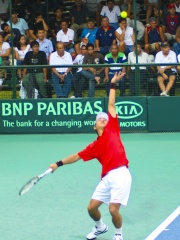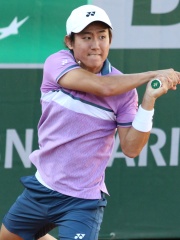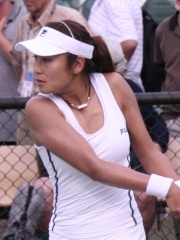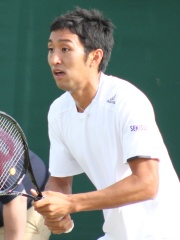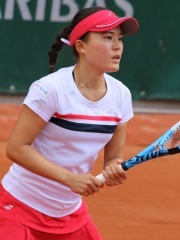
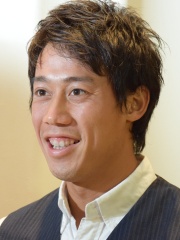
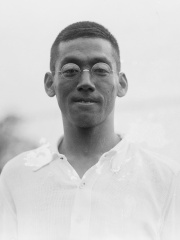
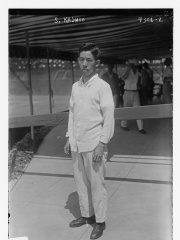
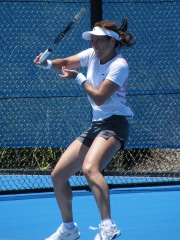
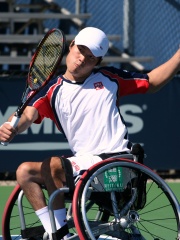

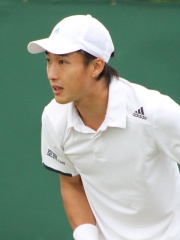
The Most Famous
TENNIS PLAYERS from Japan
This page contains a list of the greatest Japanese Tennis Players. The pantheon dataset contains 1,148 Tennis Players, 24 of which were born in Japan. This makes Japan the birth place of the 16th most number of Tennis Players behind Slovakia and Netherlands.
Top 10
The following people are considered by Pantheon to be the top 10 most legendary Japanese Tennis Players of all time. This list of famous Japanese Tennis Players is sorted by HPI (Historical Popularity Index), a metric that aggregates information on a biography’s online popularity. Visit the rankings page to view the entire list of Japanese Tennis Players.

1. Naomi Osaka (1997 - )
With an HPI of 53.53, Naomi Osaka is the most famous Japanese Tennis Player. Her biography has been translated into 66 different languages on wikipedia.
Naomi Osaka (Japanese: 大坂 なおみ, Hepburn: Ōsaka Naomi, Japanese pronunciation: [oːsaka naomi], born October 16, 1997) is a Japanese professional tennis player. She has been ranked world No. 1 in singles by the Women's Tennis Association (WTA) and is the first Asian player to hold the top ranking in singles. Osaka is a four-time Grand Slam singles champion, with two Australian Open and two US Open titles. Her seven titles on the WTA Tour also include two at the Premier Mandatory level. At the 2018 US Open and the 2019 Australian Open, Osaka won her first two major titles in back-to-back tournaments. She was the first woman to win successive major singles titles since Serena Williams in 2015, and the first to win her first two in successive majors since Jennifer Capriati in 2001. Osaka was born in Japan to a Haitian-American father and a Japanese mother. She has lived and trained in the United States since age three. She came to prominence at age 16 when she defeated former US Open champion Samantha Stosur in her WTA Tour debut at the 2014 Stanford Classic. Two years later, she reached her first WTA final at the 2016 Pan Pacific Open in Tokyo to enter the top 50 of the WTA rankings. Osaka made her breakthrough into the upper echelon of women's tennis in 2018 when she won her first WTA title at the Indian Wells Open. Later that year, she defeated 23-time Grand Slam singles champion Serena Williams in the final of the US Open to become the first Japanese player to win a major singles title. From 2018 to 2021, Osaka won a major singles title in four consecutive years. In mid-2021, suffering from depression and other issues, Osaka retired from the French Open, dropped out of Wimbledon, and lost early at the US Open. She closed down the rest of her tennis season to focus on family and health. After taking another hiatus in 2023 due to maternity leave, Osaka has returned to competition in 2024. Osaka is one of the world's most marketable athletes, having been ranked eighth among all athletes in endorsement income in 2020. She was also the highest-earning female athlete of all time by annual income that year. Osaka has gained significant recognition as an activist, having showcased support for the Black Lives Matter movement in conjunction with her matches. She was named one of the 2020 Sports Illustrated Sportspersons of the Year for her activism largely as part of her US Open championship run, and was also included on Time's annual list of the 100 most influential people in the world in 2019, 2020 and 2021. Moreover, she was the 2021 Laureus World Sportswoman of the Year. At the 2020 Tokyo Olympics, she became the first tennis player to light the Olympic cauldron during the opening ceremony. On the court, Osaka has an aggressive playing style with a powerful serve that can reach 201 kilometers per hour (125 mph).

2. Kei Nishikori (1989 - )
With an HPI of 46.08, Kei Nishikori is the 2nd most famous Japanese Tennis Player. His biography has been translated into 49 different languages.
Kei Nishikori (錦織 圭, Nishikori Kei, [ɲiɕi̥koꜜɾi keꜜː]; born 29 December 1989) is a Japanese professional tennis player. He is the second male Japanese player to have been ranked in the top five in singles (after Jiro Sato), and the only one to do so in the Open Era. Nishikori first reached his career-high singles ranking of world No. 4 in March 2015. Nishikori has won six ATP Tour 500 titles, six ATP Tour 250 titles and was runner-up at the 2014 US Open, making him the first man representing an Asian country to reach a major singles final. He also became the first man from Asia to qualify for the ATP Finals, and reached the semifinals in 2014 and 2016. In addition, Nishikori defeated Rafael Nadal to win the bronze medal at the 2016 Summer Olympics, bringing Japan its first Olympic tennis medal in 96 years. He holds the record for the highest win percentage in matches extending to five sets, with a record of 27–7 and a win percentage of 79.4%.

3. Ichiya Kumagae (1890 - 1968)
With an HPI of 44.26, Ichiya Kumagae is the 3rd most famous Japanese Tennis Player. His biography has been translated into 21 different languages.
Ichiya "Ichy" Kumagae (熊谷 一弥, Kumagai Ichiya, 10 September 1890 – 16 August 1968) was a Japanese tennis player and the first Japanese Olympic medalist.

4. Seiichiro Kashio (1892 - 1962)
With an HPI of 42.46, Seiichiro Kashio is the 4th most famous Japanese Tennis Player. His biography has been translated into 17 different languages.
Seiichiro Kashio (柏尾 誠一郎, Kashio Seiichirō, January 2, 1892 – September 6, 1962) was a tennis player from Japan, and with Ichiya Kumagae was one of the first Japanese Olympic medalists. He won the Canadian Open by defeating United States player Walter Wesbrook 3–6, 6–3, 6–1, 11–9.
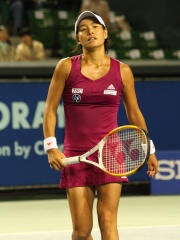
5. Kimiko Date (1970 - )
With an HPI of 41.70, Kimiko Date is the 5th most famous Japanese Tennis Player. Her biography has been translated into 31 different languages.
Kimiko Date (伊達 公子, Date Kimiko, born 28 September 1970) is a Japanese former professional tennis player. She reached the semifinals of the 1994 Australian Open, the 1995 French Open and the 1996 Wimbledon Championships, and won the Japan Open a record four times. She reached a career-high ranking of world No. 4 in 1995, and retired from professional tennis in November 1996. She returned to tennis nearly 12 years later, announcing an unexpected comeback in April 2008. She then won her eighth WTA title at the 2009 Korea Open, becoming the second-oldest player in the Open era, after Billie Jean King, to win a singles title on the WTA Tour. In 2013, she won three WTA Tour titles in doubles and at the 2014 US Open, aged 43, she reached the semifinals of a Grand Slam doubles tournament for the first time in her career. Date announced her final retirement in September 2017.

6. Ai Sugiyama (1975 - )
With an HPI of 39.05, Ai Sugiyama is the 6th most famous Japanese Tennis Player. Her biography has been translated into 32 different languages.
Ai Sugiyama (杉山愛, Sugiyama Ai, born July 5, 1975) is a Japanese former tennis player. She reached the world No. 1 ranking in women's doubles on the WTA Tour and had a career-high singles ranking of world No. 8, achieved on February 9, 2004. In her career, she won six singles and 38 doubles titles, including three Grand Slam titles (one with Julie Halard-Decugis and two partnering Kim Clijsters), and one Grand Slam mixed doubles title (partnering Mahesh Bhupathi). Sugiyama held the all-time record, for both male and female players, for her 62 consecutive Grand Slam main-draw appearances, until she was surpassed by Roger Federer at the 2015 Wimbledon Championships.

7. Shingo Kunieda (1984 - )
With an HPI of 34.33, Shingo Kunieda is the 7th most famous Japanese Tennis Player. His biography has been translated into 15 different languages.
Shingo Kunieda (国枝 慎吾, Kunieda Shingo, born February 21, 1984) is a Japanese former wheelchair tennis player. With four Paralympic gold medals, 28 major singles titles – an all-time record in singles of any tennis discipline – and 50 major titles overall, Kunieda is widely considered the greatest male wheelchair player of all time. Kunieda was the ITF World Champion from 2007 to 2010. He was also the year-end No. 1 in doubles in 2007. In 2007, 2009, 2010, 2014, and 2015, Kunieda won all three singles majors that hosted wheelchair singles events (Wimbledon did not do so until 2016). In 2007 and 2008, Kunieda also won three of the four Masters series events. Kunieda is the only male player to retain the men's singles title at the Paralympics – he took the gold medal in 2008, 2012 and 2020. In addition, Kunieda won the gold medal in the 2004 men's doubles, and has been part of two World Team Cup wins. He has 103 career titles over singles and doubles combined, including 50 majors. Kunieda had a three-year, 106-match consecutive win streak. The streak began after his loss at the 2007 Masters and ended to Stéphane Houdet in the semifinals of the 2010 Masters. In late 2012 to early 2013, Kunieda had a win streak of 44 matches. Between January 2014 and December 2015, Kunieda was on yet another winning streak of 77 matches, ending to Joachim Gérard in the round-robin phase of the 2015 NEC Masters tournament. Kunieda is a right-handed player whose favorite surface is hard court. He was coached by Hiromichi Maruyama. He announced his retirement in January 2023.

8. Shuko Aoyama (1987 - )
With an HPI of 31.82, Shuko Aoyama is the 8th most famous Japanese Tennis Player. Her biography has been translated into 19 different languages.
Shuko Aoyama (青山 修子, Aoyama Shūko, born December 19, 1987) is a Japanese professional tennis player who specializes in doubles. Aoyama turned professional after graduating from Waseda University. She reached a career-high singles ranking of world No. 182, on 9 February 2015, and a doubles ranking of world No. 4, on 28 February 2022. She plays predominantly in doubles and has won 19 titles on the WTA Tour, having had her most successful Grand Slam appearances at the 2023 Australian Open final and at Wimbledon, reaching the semifinals at the 2013 and 2021 tournaments. She has also won four singles and 30 doubles titles on the ITF Women's Circuit.

9. Go Soeda (1984 - )
With an HPI of 31.28, Go Soeda is the 9th most famous Japanese Tennis Player. His biography has been translated into 20 different languages.
Go Soeda (添田 豪, Soeda Gō, born September 5, 1984) is a former professional Japanese tennis player. He started playing tennis at the age of four and turned professional in April 2003. He has won 18 singles titles on the ATP Challenger Tour, and achieved a career-high singles ranking of world No. 47 on 23 July 2012.
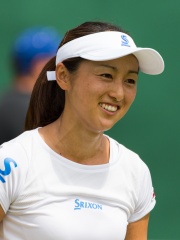
10. Misaki Doi (1991 - )
With an HPI of 30.48, Misaki Doi is the 10th most famous Japanese Tennis Player. Her biography has been translated into 22 different languages.
Misaki Doi (土居 美咲, Doi Misaki, born 29 April 1991) is a Japanese former professional tennis player. Her highest WTA rankings are No. 30 in singles and No. 77 in doubles. Doi reached two junior Grand Slam doubles finals – at Wimbledon in 2007 with Kurumi Nara, and at the Australian Open in 2008, with Elena Bogdan (losing both). She has made it to three WTA tournament finals (only winning one). She is managed by Muse Group, a sports marketing agency based in Tokyo.
Pantheon has 24 people classified as tennis players born between 1890 and 1997. Of these 24, 22 (91.67%) of them are still alive today. The most famous living tennis players include Naomi Osaka, Kei Nishikori, and Kimiko Date. The most famous deceased tennis players include Ichiya Kumagae and Seiichiro Kashio. As of April 2022, 4 new tennis players have been added to Pantheon including Shingo Kunieda, Yoshihito Nishioka, and Yasutaka Uchiyama.
Living Tennis Players
Go to all Rankings
Naomi Osaka
1997 - Present
HPI: 53.53
Kei Nishikori
1989 - Present
HPI: 46.08
Kimiko Date
1970 - Present
HPI: 41.70
Ai Sugiyama
1975 - Present
HPI: 39.05
Shingo Kunieda
1984 - Present
HPI: 34.33
Shuko Aoyama
1987 - Present
HPI: 31.82
Go Soeda
1984 - Present
HPI: 31.28
Misaki Doi
1991 - Present
HPI: 30.48
Shinobu Asagoe
1976 - Present
HPI: 30.08
Takao Suzuki
1976 - Present
HPI: 29.84
Yoshihito Nishioka
1995 - Present
HPI: 29.13
Akiko Morigami
1980 - Present
HPI: 29.11

Deceased Tennis Players
Go to all RankingsNewly Added Tennis Players (2022)
Go to all Rankings
Shingo Kunieda
1984 - Present
HPI: 34.33
Yoshihito Nishioka
1995 - Present
HPI: 29.13
Yasutaka Uchiyama
1992 - Present
HPI: 25.57
Makoto Ninomiya
1994 - Present
HPI: 22.55



